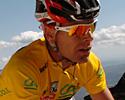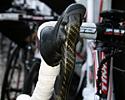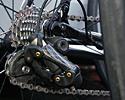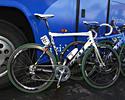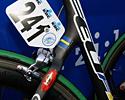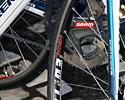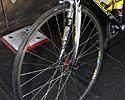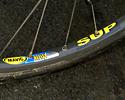
Recently on Cyclingnews.com |
Race Tech: Ronde van Vlaanderen, April 7, 2008
Bring on the cobbles!
By James Huang in Brugge, Belgium
New version of electronic Campagnolo Record group spotted
|
|
|
Just when we were pretty confident that Campagnolo had nearly finalized the design for its own electronic group, a new version showed up at the start of this year's Ronde van Vlaanderen. The derailleurs looked to be essentially unchanged from what we'd seen prior but the levers were wholly new items and the battery housing looks to have received some minor tweaks to allow the use of a standard bottle cage instead of the integrated carbon unit.
Relative to the modified Ergopower test mules we're used to seeing, the new levers bear an all-new shape with longer and curvier carbon brake lever blades. The significant length of lever blade on top of the pivot location suggests to us that adjustable reach might also be incorporated here (now a virtually required feature courtesy of SRAM's new Red levers).
The lever body is bigger, too, with a more pronounced and inwardly canted peak that provides a perfect place to hook your thumbs when you're dropping your elbows and getting low. Despite the dramatically different appearance, though, the new shape actually feels quite similar to standard Ergopower levers as the primary contact surface locations are mostly unchanged.
This latest iteration also boasts a functional change as the inboard thumb paddles have disappeared in favor of shrouded push buttons. A second button paired with the shift button is apparently used to operate the associated Ergobrain computer.
Even though this is the first time we're aware of that the new levers have made a public appearance, they look surprisingly close to production items save for the somewhat rough fit of the hoods. If these were true prototypes we would have expected the bodies and lever blades to be made using typical small batch procedures such as CNC machining, SLA (stereolithography) or SLS (selective laser sintering), yet the composite body and carbon lever blades indicate that final, or nearly final, molds have already been cut.
Slipstream saves Paris-Roubaix bikes for the big show
|
|
|
The Ronde van Vlaanderen is littered with stretches of cobbles but their somewhat milder surfaces (?!) apparently didn't warrant the use of one-off machines in the same manner as what we usually see at Paris-Roubaix. In fact, 2004 Paris-Roubaix winner Magnus Backstedt (Slipstream-Chipotle) left the start in Brugge with his usual Felt F1 Sprint, complete with a Zipp 303 carbon tubular up front and a slightly deeper Zipp 404 in back. Save for the custom paint to commemorate his Swedish national champion status, there was little to distinguish his bike from those of the rest of the squad.
Slipstream does have Paris-Roubaix specials, though, and those bikes did still made it out on course; however, they were mounted atop the team cars as spares for the day. The current Belgian weather promises to make this year's 'hell of the north' a decidedly messier (and thus, more typical) affair than last year's uncommonly hot and dry running and from the looks of those 'spares', Slipstream riders should be ready to go.
The Paris-Roubaix Felts utilize a mix of F1 SL and F1 Sprint materials for extra strength and stiffness without too much added weight. Kevlar patches are also applied to the top tube for additional impact resistance from errantly spinning handlebars.
As is typical for the genre, there is also more tire clearance all around courtesy of longer fork blades, rangier seat stays and chain stays that are slightly indented right where the tire passes through. Unique rear dropouts decrease the bottom bracket height a bit for more stability. A 50mm-rake carbon fork offsets the longer rear end to maintain overall weight balance and also yields a longer and more stable wheelbase.
Longer-reach Shimano R600 brake calipers are used to accommodate the increased clearances but it looks like the rest of the componentry (save for the wheels, of course) will be standard team issue come next weekend.
Tried-and-true is the rule of thumb for classics wheels
|
|
|
|
|
Deep-section carbon wheels have come to dominate the scene in most road events but the vast majority of riders and teams have opted for more traditional hoops for the spring classics, including Quick Step's Stijn Devolder who soloed in for victory in front of his home crowd.
For example, Astana riders departed on Bontrager 'Limited Edition' wheels built with box-section tubular rims, DT Swiss hubs and 32 Sapim stainless steel spokes front and rear along with more rarely used brass nipples. Saunier Duval-Scott team members headed off on similarly configured wheels with Mavic box-section rims, some of which have long been out of production.
Tire selection was critical as usual and some teams cracked out some unusual selections for the Ronde van Vlaanderen to go along with their robust wheels. Durability was clearly a high priority for Crédit Agricole who used 25mm-wide Continental Pro Limited Competition ProTection tubulars with double Vectran breaker plies and Snakeskin sidewall protection. Milram, on the other hand, opted for a standard 23mm width but a deeper and more aggressive tread. The brand name on those tires was blacked out but the remaining text suggested they were Paris-Roubaix models from 'cross tire icon Dugast.
Clinchers were in the minority here but still made a few key appearances. Michelin-sponsored Bouygues Telecom riders used the new Pro3 Grip model in a 700x23c size for better traction on the uneven surfaces. As compared to the standard Pro3 Race, the most obvious difference is the addition of a slight file tread on the shoulders but we're guessing a softer compound is in use as well.
Philippe Gilbert (Française des Jeux) made history a few weeks ago with his Het Volk victory on Hutchinson's Road Tubeless system. We didn't catch his race bike before he headed off in the morning but most of the team's spare bikes were again outfitted with Shimano Dura-Ace WH-7850-SL wheels and Hutchinson Fusion 2 Road Tubeless tires. We'll have to wait and see if the team opts for the Road Tubeless rubber come Paris-Roubaix.
Photography
For a thumbnail gallery of these images, click here
Images by James Huang/Cyclingnews.com
- Campagnolo surprised us with an as yet unseen new version of its electronic group.
- The new levers are decidedly curvier (and longer) than earlier ones that were based on the standard Ergopower levers.
- In spite of the radical appearance , the levers actually feel surprisingly similar to existing versions so Campyphiles shouldn't get too worried.
- If anything, the extra 'peak' at the top of the levers…
- …now provides a perfect little hook for your thumbs.
- This version of the Campagnolo electronic levers also uses a button on the inner side of the body instead of the familiar thumb paddle.
- The rear derailleur appears mostly unchanged from what we've already seen.
- A titanium bolt mounts the new rear derailleur to the frame.
- Likewise, the front derailleur appears the same as in previous sightings.
- Campagnolo's semi-integrated battery can apparently also be used with standard bottle cages and not just the integrated carbon one we've seen before.
- Check out the novel computer mount on this Cofidis bike.
- At least one Silence-Lotto bike was also equipped with Campagnolo's electronic group.
- Slipstream's Magnus Backstedt departed from Brugge on a mostly standard machine.
- Save for the special paint and Swedish national champion graphics , Backstedt's bike was similar to those of his teammates.
- Slipstream was in the minority with its choice of mid- and deep-section carbon wheels.
- Corima carbon-specific pads continue to be a popular choice.
- Surprisingly, Backstedt opted for a carbon handlebar…
- …to go along with his massively long stem.
- A Third Eye Chain Watcher is just about the only concession made to the cobbles of Flanders.
- However, the team's Paris-Roubaix bikes were mounted atop the car for use as spares.
- The longer fork legs offer more mud clearance up top.
- Likewise, the chain stays are slightly indented on their inner surfaces for more room.
- Longer seat stays also offer more space for mud to pass. Note the long-reach Shimano R600 calipers.
- Special dropouts decrease bottom bracket height slightly for more stability.
- Belgian Stijn Devolder and the rest of his Quick Step team ran traditional box-section tubulars.
- The sticker says "Roval" but the telltale counterweight is still badged with the Ambrosio name.
- Quick Step team mechanics are apparently hording tires as Clement has been out of business for some time now.
- All of the riders' bikes started out as clean as Tom Boonen's spare, but none of them ended up that way.
- Tomas Vaitkus and his Astana team continued their spring campaign.
- Like most of the other teams , Astana opted for more traditional box-section tubulars.
- The 'Limited Edition' badging on Astana's Bontrager tubulars can otherwise be translated as 'not available to the public'.
- They're far from a new idea but the machined sidewalls probably yielded more predictable braking for the Astana riders in today's variable conditions.
- Saunier Duval-Scott ran box-section tubulars, too.
- Mavic is a team sponsor so we weren't surprised to see these…
- …but we were a bit surprised to see these seeing as how they've been out of production for years.
- Crédit Agricole riders headed out of Brugge with relatively beefy 25mm Continental tubulars fitted with dual Vectran breaker plies and Snakeskin sidewall protection.
- Milram's usual Colnago Extreme Power bikes…
- …were outfitted with rarely seen Dugast road tubulars.
- The Bouygues Telecom team didn't bother with special wheels…
- …but it did run Michelin's stickier Pro3 Grip rubber.
- Some Française des Jeux riders again opted to use Hutchinson Fusion 2 Road Tubeless tires on their Shimano Dura-Ace WH-7850-SL wheels.
- CSC's Cervélo R3 frames use almost impossibly thin-looking seat stays.
- However, if those stays can hold up under Stuart O'Grady, winner of last year's Paris-Roubaix, we dare say that they're probably plenty strong.
- Stefan Wesemann of the rebadged Cycle Collstrop team (formerly Unibet) headed towards the finish in Ninove aboard a German Canyon bike.
- Even the stem is German on Wesemann's machine.
- Top-mount brake levers and heavily taped bars were par for the course over the Flanders cobbles.
- Some Saunier Duval-Scott bars were taped a little thicker than most.
- We don't see top-mount brake levers on the road too often but the cobbles call for unique equipment.
- SRAM's Red group continues to challenge the spring classics and this Saunier Duval-Scott rider appears to be particularly fond of the adjustable reach feature as his levers were set rather close to the bar.
- A few extra grams of plastic go a long way to providing some welcome security in harsh conditions.
- This Bouygues Telecom rider went with some makeshift padding between his seatpost head and saddle shell. We're guessing it's a scrap chunk of Michelin tire judging by the color.
- There's actually so much extra padding stuffed in the space that the saddle shell is bowed slightly upwards.
- Milram riders were taking no chances with clearly labeled cobbled sections and climbs…
- …as well as Garmin Edge 305 GPS units to make sure they knew exactly where they were on the course.
- Shoe covers were standard fare for today. Even if their bodies were wet, at least the riders' feet were dry and sometimes that can make all the difference.
